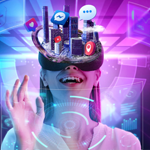The future of augmented reality (AR), virtual reality (VR), and extended reality (XR) in the marketing industry is incredibly exciting. These technologies offer new and innovative ways for businesses to engage with their customers and promote their products and services.
One of the most significant benefits of AR, VR, and XR is their ability to provide immersive experiences. For example, a customer can try on virtual clothing or see how a piece of furniture would look in their home before making a purchase. This level of engagement can lead to increased brand loyalty and higher conversion rates.
Another advantage of these technologies is their ability to provide customers with valuable information. For example, an AR-enabled product catalog can provide customers with detailed product information and comparisons, allowing them to make more informed purchasing decisions. Additionally, VR and XR can be used to create virtual showrooms and product demonstrations, providing customers with a more engaging and interactive shopping experience.
As the technology continues to advance, we can expect to see an increase in the use of AR, VR, and XR in the marketing industry. This will include the integration of these technologies into mobile apps, e-commerce websites, and even physical retail stores. Businesses that embrace these technologies will be able to stay ahead of the competition and provide their customers with a more engaging and personalized shopping experience.
In conclusion, AR, VR, and XR are set to revolutionize the marketing industry by offering immersive, engaging, and personalized experiences that can increase brand loyalty and conversion rates. Businesses that invest in these technologies now will be well-positioned to capitalize on the future of marketing.






